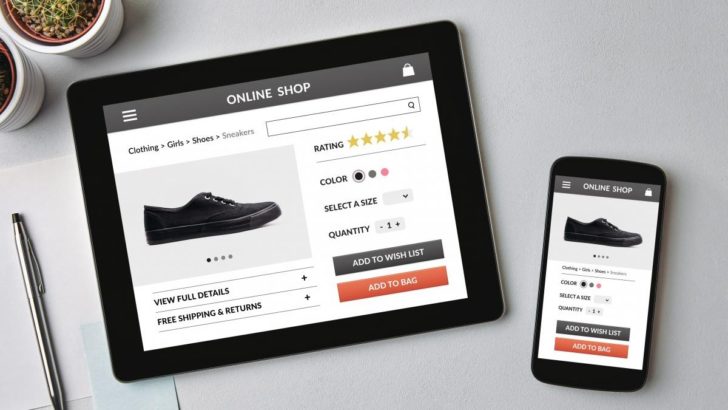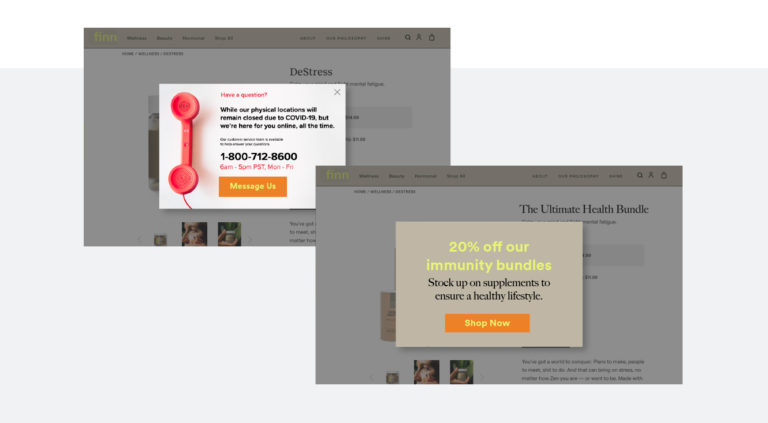30-second summary:
- While it has always been important to optimize PDPs, which serve as one of the main entry points to a site, it is a good time for online retailers to maximize the performance of traffic to these pages, ensuring high-intent visitors are able to find what they are looking for.
- Product recommendations are consistently used to surface relevant items for visitors on PDPs. However, brands can influence browsing even further by creating a richer recommendation experience.
- Sometimes, a shopper lands on a PDP via search and either finds the item doesn’t meet their original expectations or they’re interested in exploring other similar products. To best serve these visitors, brands should allow for easy navigation back to the product’s main category.
- To reduce the likelihood of a visitor bouncing from the site, brands should consider employing exit-intent popups.
- While many consumers are now stuck at home, they may still want to browse for products they’d be interested in purchasing in the future. A great way to incentivize these shoppers to come back to the site is by allowing them to add items to a wish list.
- The coronavirus outbreak has greatly impacted both consumers and the retailers doing their best to serve them. By optimizing these entry points, brands can not only better connect their search traffic with the products and information shoppers need, but also increase the likelihood of conversions.
Over the last few weeks, the coronavirus has triggered massive shifts in shopping behavior across affected regions, as many physical retail locations have begun operating under limited hours or have temporarily shut their doors.
Now largely reliant on ecommerce, consumers uncertain about the future are bulk-purchasing necessities and ordering otherwise non-standard items to make their extended periods at home feel more comfortable.
Among these new patterns, some brands are experiencing increases in organic search traffic, which is traditionally the second-largest source of overall monthly ecommerce traffic.
As shoppers take to Google in search of unfamiliar or high-demand products, retailers – especially those dealing in essential goods – can expect organic traffic to rise
While it has always been important to optimize Product Detail Pages (PDPs), which serve as one of the main entry points to a site, it is a good time for online retailers to maximize the performance of traffic to these pages, ensuring high-intent visitors are able to find what they are looking for.
Below, discover a few tips we’ve seen successfully implemented to improve product discovery, reduce bounce rates, and keep brands top of mind throughout an entirely new purchase decision process.
Surface more product recommendations on PDPs
Product recommendations are consistently used to surface relevant items for visitors on PDPs. However, brands can influence browsing even further by creating a richer recommendation experience.
For example, instead of just one recommendation widget, brands can include several, each experimenting with a different strategy, such as “Bought Together” or “Similar To.”
An example of product detail pages (PDPs) featuring two recommendation widgets: one employing a Bought Together strategy and the other, “Similarity”
Additionally, Pinterest-style recommendations with infinite scroll can serve to continuously expose and recommend new items to visitors, enticing them to keep exploring until they stumble upon the right product.
An example of PDPs featuring Pinterest-style recommendations
Offer easy navigation back to the main category
Sometimes, a shopper lands on a PDP via search and either finds the item doesn’t meet their original expectations or they’re interested in exploring other similar products. To best serve these visitors, brands should allow for easy navigation back to the product’s main category.
By placing a category discovery banner at the top of the product page, brands ensure that visitors won’t have to hunt for the category page on their own from within the navigation menu or via an entirely new search. This is especially useful for mobile traffic, where limited real estate creates barriers to browsing the site.
An example of PDPs displaying a discovery banner for visitors to easily navigate to the main category
Keep distractions at bay with value-adding popups on PDPs
On a regular day, consumers experience multiple distractions throughout the online shopping experience, whether they’re comparing items across different sites, toggling between devices, or jumping from one scenario to another.
With constant, frantic COVID-19 alerts, the crisis represents an entirely new challenge, making it even harder to capture and hold visitors’ attention.
To reduce the likelihood of a visitor bouncing from the site, brands should consider employing exit-intent popups.
Triggered when a visitor idles on the page for an extended period of time, scrolls down to a certain portion of the page, or upon displaying exit intent, these overlays can be used to narrow down a shopper’s focus and highlight key messaging.
These popups may highlight promotional offers to encourage a purchase or important COVID-19-related updates, such as current business hours and delivery windows.
An example of two exit-intent popups used to promote an offer or specific message on PDPs
Allow shoppers to add items to a wish list via PDPs
While many consumers are now stuck at home, they may still want to browse for products they’d be interested in purchasing in the future. A great way to incentivize these shoppers to come back to the site is by allowing them to add items to a wish list.
Once created, offering quick access to their list makes it easy to add saved items to their shopping cart for fast checkout.
Wish lists are also effective tools for capturing subscribers, which brands can then leverage to identify and further nurture the relationship via other channels, such as email.
PDPs featuring a link for shoppers to add items to a wish list
Assist like never before
The coronavirus outbreak has greatly impacted both consumers and the retailers doing their best to serve them.
By optimizing these entry points, brands can not only better connect their search traffic with the products and information shoppers need, but also increase the likelihood of conversions.
More importantly, although not all of this new traffic is guaranteed to translate into revenue, in making some of these changes, brands stand to communicate that they are being mindful of consumer needs during this unprecedented situation – the benefits of which will have a lasting impact, long after COVID-19 eventually subsides.









